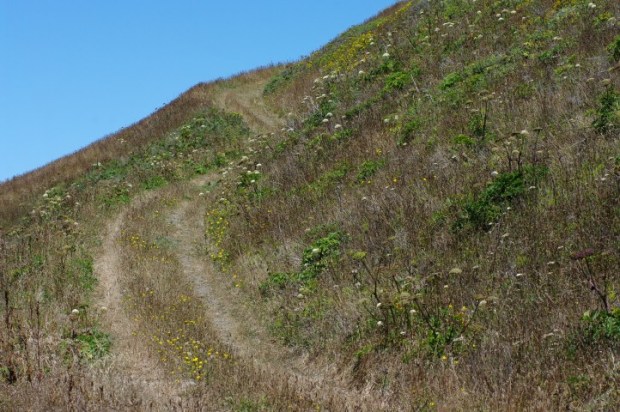Hiking to the Punta Gorda Lighthouse on the Lost Coast

Some people call this California’s Lost Coast. I prefer to think of it as the Saved Coast. Plenty of this section of California’s coast has been tied up by ranching and grazing for generations and is closed to public access, but there are also long, lonely stretches of coast in the public domain. Together, the King Range National Conservation Area and the Sinkyone Wilderness State Park cover about 50 contiguous miles along the Lost Coast. This really is wilderness — the State Park’s website warns: because of the staff shortage, visitors are also advised to bring toilet paper with them as there may not be personnel to maintain an adequate level of supplies in park facilities. As Paul mentioned in an earlier post, the roads are terrible and civilization is sparse. It’s perfect.
Mattole Beach, where we camped for a few nights, is at the northern tip of the King Range area. We learned from our campsite neighbors about an abandoned lighthouse three and a half miles south down the coast — the Punta Gorda lighthouse. You can also drive to the lighthouse on a really rough dirt road, but we didn’t think CoCoVan would make it. At one time, this was one of the most secluded lighthouses along the coast. It was abandoned in 1951, replaced by a modern beacon offshore.
Punta Gorda loosely means “point of the fat woman.” At least, that’s what it literally translates to in my mind.
We set out on the hike after breakfast, forgetting how hard it is to hike on coarse sand. The black sand in this area is very loose, so much so that you don’t even get a break while walking along the waterline. We plodded along, sometimes on the beach and sometimes along the foot of the bluff, where the walking was easier but the trail was bordered by lush groves of poison oak.
We hadn’t really intended to go all the way to the lighthouse, but we kept finding little surprises around every corner that drew us onward. There were shell and bone middens, left behind by the Sinkyone Indians. There were lots and lots of harbor seals, staring up at us cautiously and curiously from the rocks just offshore. There were tidepools filled with little creatures like starfish. There was a remote camp along the coast — two cedar-shaked buildings, an outhouse, and a single lane road. Along the trail, beside the poison oak, were all kinds of flowering plants and shrubs that emitted a delicious, herbaceous scent. It smelled like a warm spice drawer. We didn’t see any boats, planes, paved roads, or cars. Little streams flowed off the hills above and were absorbed into the sand below.
We also saw a few disturbing things, like a dead harbor seal and a bunch of dead pelicans (we learned from the local paper that the pelicans were getting covered with fish oil at the nearby fisheries). I can’t even begin to describe to you how terrible a dead harbor seal smells. There was a point that we had to round that funneled the wind into what felt like a 50-60 mph torrent. It took all of our physical strength to fight through. Supposedly, the coast is often submerged in fog, but it was sunny and gorgeous all four days of our visit, though fog often shrouded the hilltops.
The lighthouse itself is small and picturesque. You can climb right up the rusty ladder into the tower. Instead of lighthouse gear, it’s now filled with swallows and their muddy nests.
Plodding back, I started to get seriously exhausted after about mile six. I couldn’t wait to get back to our site, eat some lunch, and crash in our fort (aka tent). For the first time, I could understand how easy it would be to push yourself to a dangerous point. Unlike anywhere else in California, you’re really on your own out here.
I hope the Saved Coast never changes.















